Brand Management Report: Analysis of JP Morgan and M&S Brands
VerifiedAdded on 2020/10/23
|15
|4958
|426
Report
AI Summary
This report provides a detailed analysis of brand management, examining the strategies employed by JP Morgan and Marks & Spencer. The assignment begins with an introduction to brand management, defining key concepts such as brand equity and the importance of branding in creating a strong market presence. Task 1 focuses on JP Morgan, exploring its brand equity, the Keller Customer-Based Brand Equity Model, and various marketing strategies including competitive analysis and standard quality products. Task 2 shifts the focus to Marks & Spencer, analyzing its brand portfolio strategy, specifically the branded house model, and illustrating the hierarchy management of brands using the Aaker brand equity model. The report further investigates the strategies used by Marks & Spencer for managing brand equity, brand awareness, and brand value. Task 3 assesses the strengths and weaknesses of both brands, suggesting collaborative and partnership agreements. Finally, Task 4 delves into the measurement of brand value, brand awareness, market share, consumer attitudes, and purchasing intent, concluding with an overview of the findings and recommendations for both companies. The report comprehensively covers the nuances of brand management.
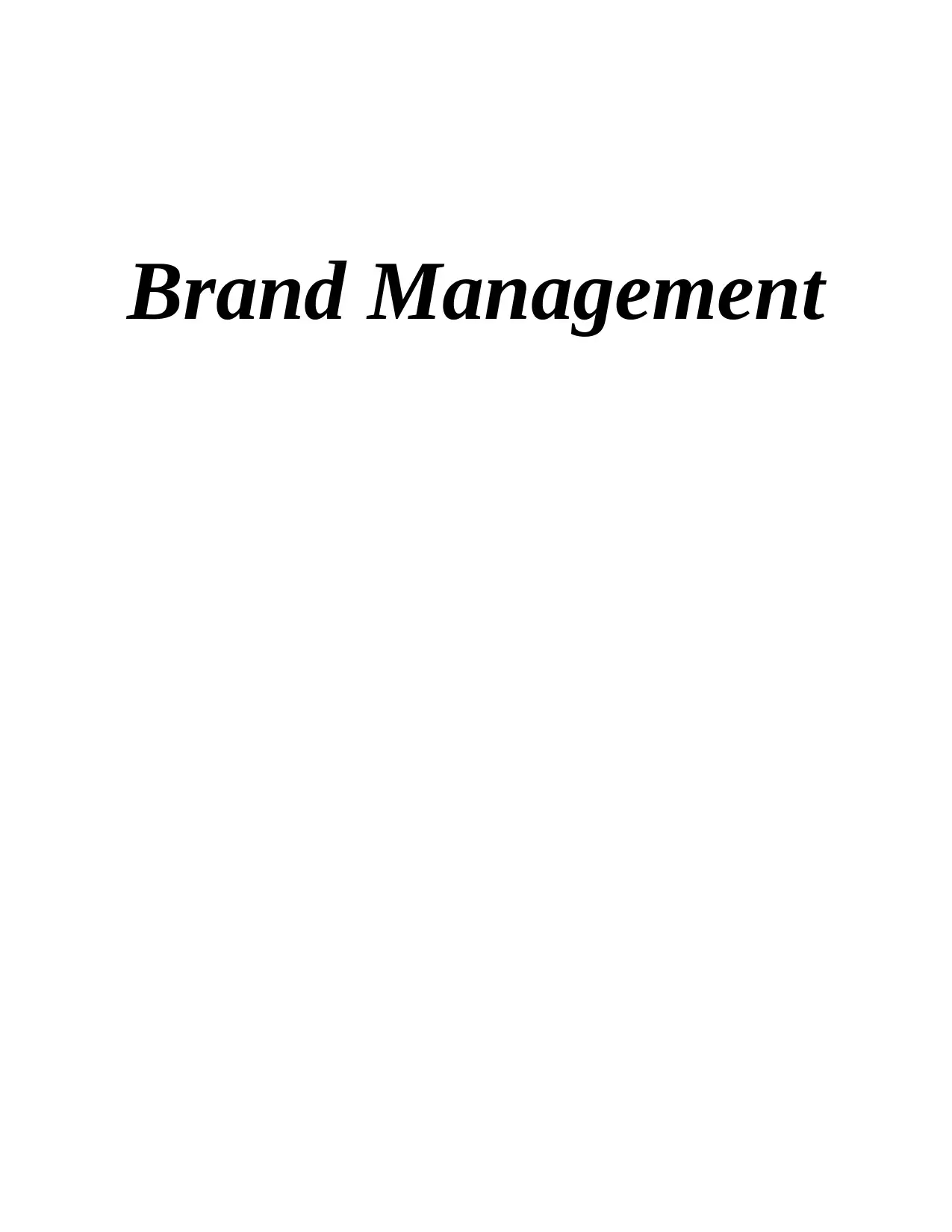
Brand Management
Paraphrase This Document
Need a fresh take? Get an instant paraphrase of this document with our AI Paraphraser
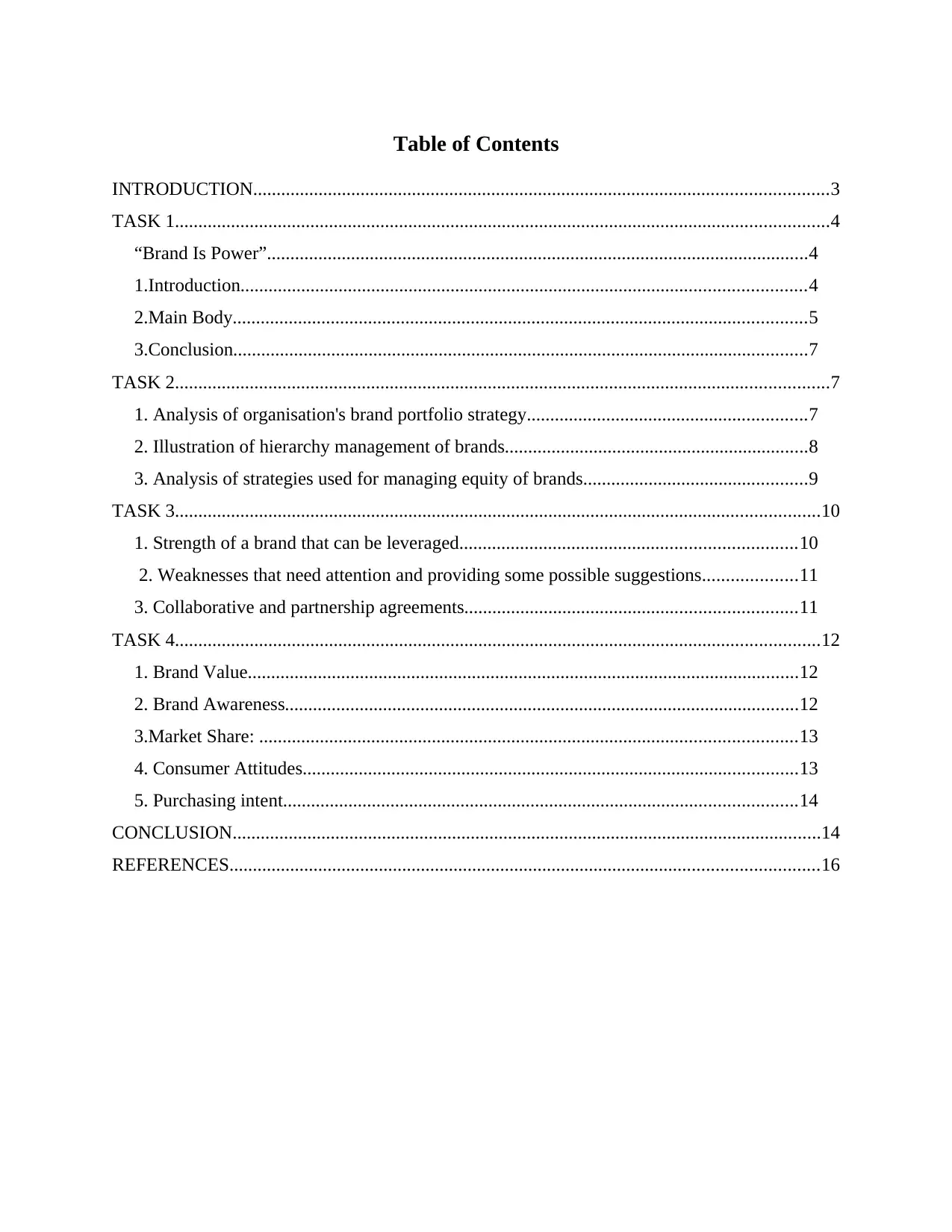
Table of Contents
INTRODUCTION...........................................................................................................................3
TASK 1............................................................................................................................................4
“Brand Is Power”....................................................................................................................4
1.Introduction.........................................................................................................................4
2.Main Body...........................................................................................................................5
3.Conclusion...........................................................................................................................7
TASK 2............................................................................................................................................7
1. Analysis of organisation's brand portfolio strategy............................................................7
2. Illustration of hierarchy management of brands.................................................................8
3. Analysis of strategies used for managing equity of brands................................................9
TASK 3..........................................................................................................................................10
1. Strength of a brand that can be leveraged........................................................................10
2. Weaknesses that need attention and providing some possible suggestions....................11
3. Collaborative and partnership agreements.......................................................................11
TASK 4..........................................................................................................................................12
1. Brand Value......................................................................................................................12
2. Brand Awareness..............................................................................................................12
3.Market Share: ...................................................................................................................13
4. Consumer Attitudes..........................................................................................................13
5. Purchasing intent..............................................................................................................14
CONCLUSION..............................................................................................................................14
REFERENCES..............................................................................................................................16
INTRODUCTION...........................................................................................................................3
TASK 1............................................................................................................................................4
“Brand Is Power”....................................................................................................................4
1.Introduction.........................................................................................................................4
2.Main Body...........................................................................................................................5
3.Conclusion...........................................................................................................................7
TASK 2............................................................................................................................................7
1. Analysis of organisation's brand portfolio strategy............................................................7
2. Illustration of hierarchy management of brands.................................................................8
3. Analysis of strategies used for managing equity of brands................................................9
TASK 3..........................................................................................................................................10
1. Strength of a brand that can be leveraged........................................................................10
2. Weaknesses that need attention and providing some possible suggestions....................11
3. Collaborative and partnership agreements.......................................................................11
TASK 4..........................................................................................................................................12
1. Brand Value......................................................................................................................12
2. Brand Awareness..............................................................................................................12
3.Market Share: ...................................................................................................................13
4. Consumer Attitudes..........................................................................................................13
5. Purchasing intent..............................................................................................................14
CONCLUSION..............................................................................................................................14
REFERENCES..............................................................................................................................16
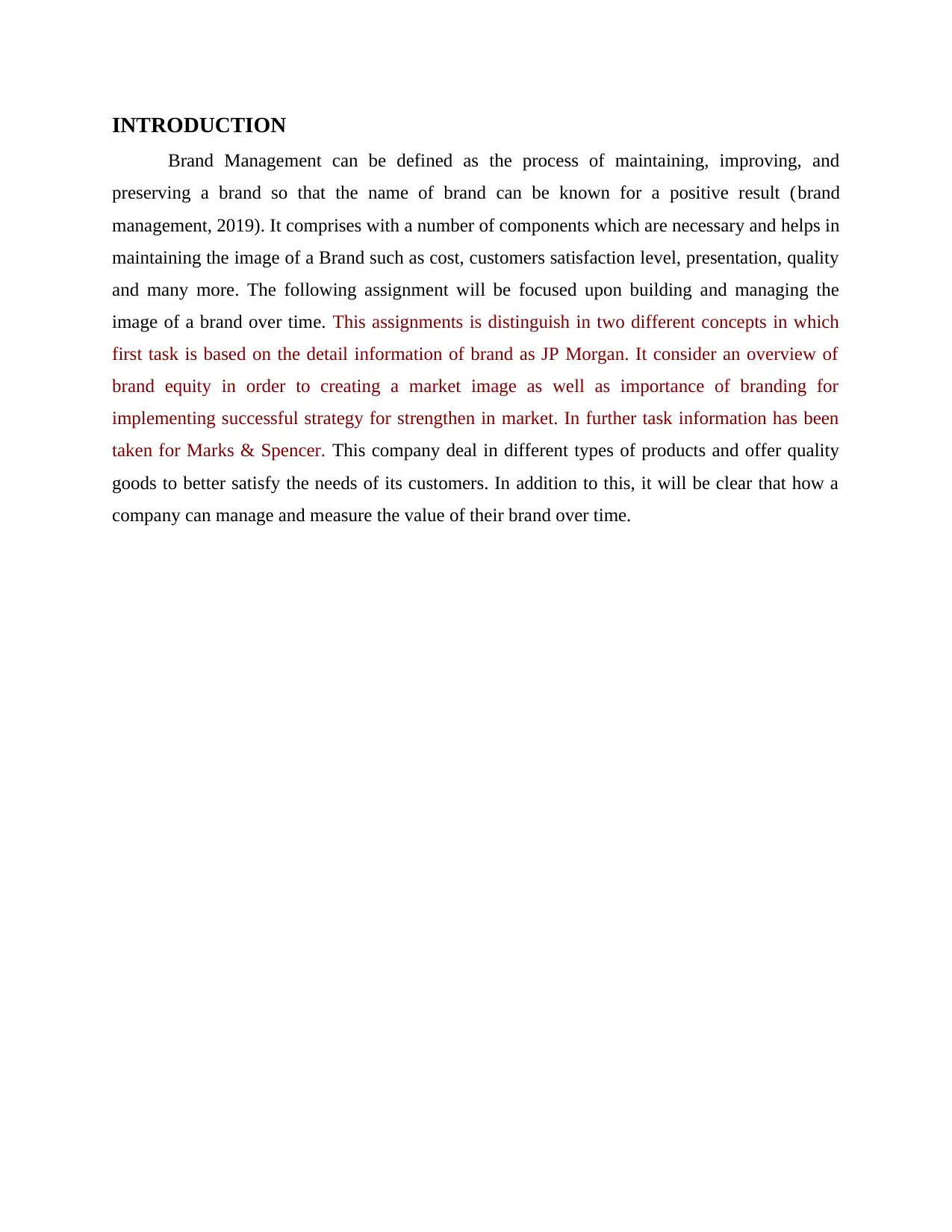
INTRODUCTION
Brand Management can be defined as the process of maintaining, improving, and
preserving a brand so that the name of brand can be known for a positive result (brand
management, 2019). It comprises with a number of components which are necessary and helps in
maintaining the image of a Brand such as cost, customers satisfaction level, presentation, quality
and many more. The following assignment will be focused upon building and managing the
image of a brand over time. This assignments is distinguish in two different concepts in which
first task is based on the detail information of brand as JP Morgan. It consider an overview of
brand equity in order to creating a market image as well as importance of branding for
implementing successful strategy for strengthen in market. In further task information has been
taken for Marks & Spencer. This company deal in different types of products and offer quality
goods to better satisfy the needs of its customers. In addition to this, it will be clear that how a
company can manage and measure the value of their brand over time.
Brand Management can be defined as the process of maintaining, improving, and
preserving a brand so that the name of brand can be known for a positive result (brand
management, 2019). It comprises with a number of components which are necessary and helps in
maintaining the image of a Brand such as cost, customers satisfaction level, presentation, quality
and many more. The following assignment will be focused upon building and managing the
image of a brand over time. This assignments is distinguish in two different concepts in which
first task is based on the detail information of brand as JP Morgan. It consider an overview of
brand equity in order to creating a market image as well as importance of branding for
implementing successful strategy for strengthen in market. In further task information has been
taken for Marks & Spencer. This company deal in different types of products and offer quality
goods to better satisfy the needs of its customers. In addition to this, it will be clear that how a
company can manage and measure the value of their brand over time.
⊘ This is a preview!⊘
Do you want full access?
Subscribe today to unlock all pages.

Trusted by 1+ million students worldwide
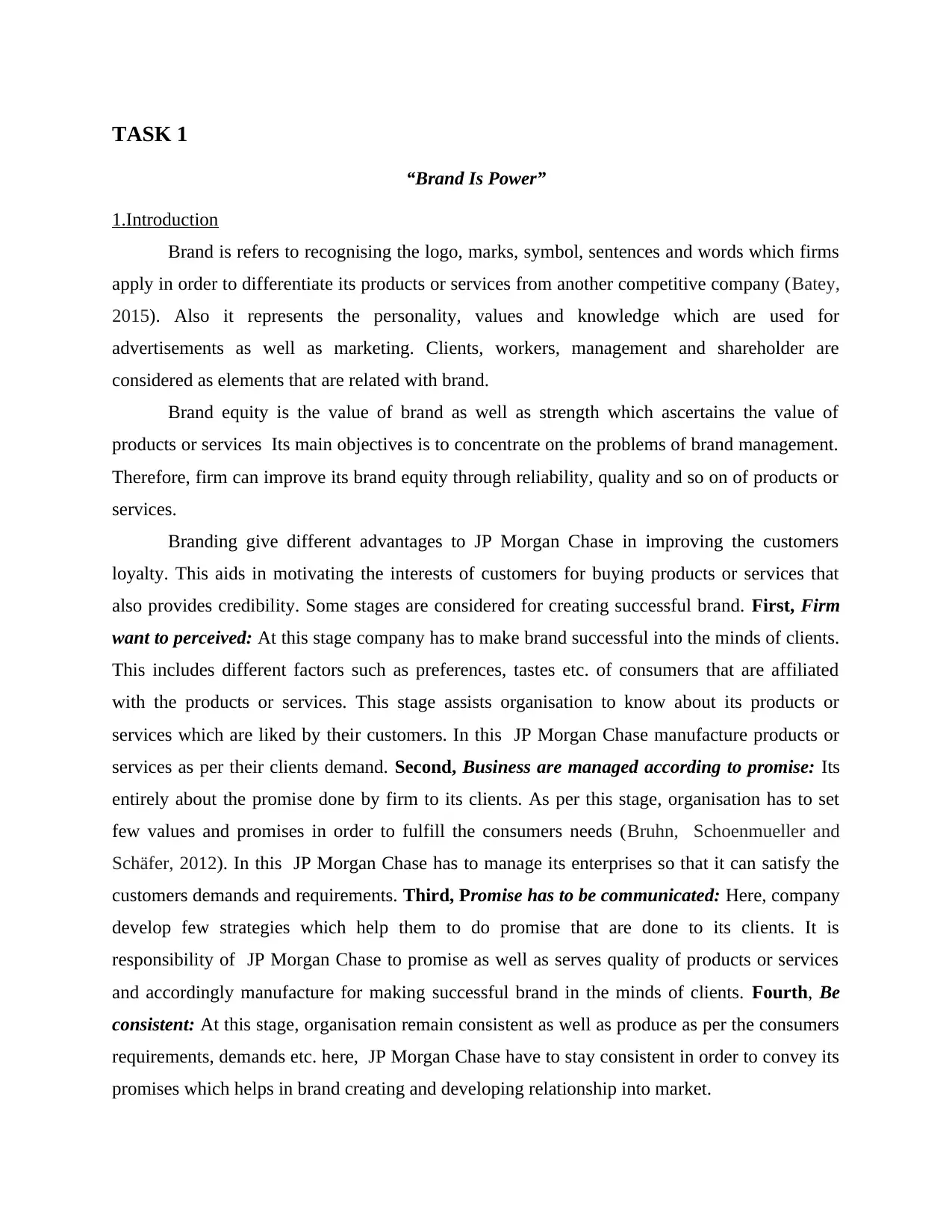
TASK 1
“Brand Is Power”
1.Introduction
Brand is refers to recognising the logo, marks, symbol, sentences and words which firms
apply in order to differentiate its products or services from another competitive company (Batey,
2015). Also it represents the personality, values and knowledge which are used for
advertisements as well as marketing. Clients, workers, management and shareholder are
considered as elements that are related with brand.
Brand equity is the value of brand as well as strength which ascertains the value of
products or services Its main objectives is to concentrate on the problems of brand management.
Therefore, firm can improve its brand equity through reliability, quality and so on of products or
services.
Branding give different advantages to JP Morgan Chase in improving the customers
loyalty. This aids in motivating the interests of customers for buying products or services that
also provides credibility. Some stages are considered for creating successful brand. First, Firm
want to perceived: At this stage company has to make brand successful into the minds of clients.
This includes different factors such as preferences, tastes etc. of consumers that are affiliated
with the products or services. This stage assists organisation to know about its products or
services which are liked by their customers. In this JP Morgan Chase manufacture products or
services as per their clients demand. Second, Business are managed according to promise: Its
entirely about the promise done by firm to its clients. As per this stage, organisation has to set
few values and promises in order to fulfill the consumers needs (Bruhn, Schoenmueller and
Schäfer, 2012). In this JP Morgan Chase has to manage its enterprises so that it can satisfy the
customers demands and requirements. Third, Promise has to be communicated: Here, company
develop few strategies which help them to do promise that are done to its clients. It is
responsibility of JP Morgan Chase to promise as well as serves quality of products or services
and accordingly manufacture for making successful brand in the minds of clients. Fourth, Be
consistent: At this stage, organisation remain consistent as well as produce as per the consumers
requirements, demands etc. here, JP Morgan Chase have to stay consistent in order to convey its
promises which helps in brand creating and developing relationship into market.
“Brand Is Power”
1.Introduction
Brand is refers to recognising the logo, marks, symbol, sentences and words which firms
apply in order to differentiate its products or services from another competitive company (Batey,
2015). Also it represents the personality, values and knowledge which are used for
advertisements as well as marketing. Clients, workers, management and shareholder are
considered as elements that are related with brand.
Brand equity is the value of brand as well as strength which ascertains the value of
products or services Its main objectives is to concentrate on the problems of brand management.
Therefore, firm can improve its brand equity through reliability, quality and so on of products or
services.
Branding give different advantages to JP Morgan Chase in improving the customers
loyalty. This aids in motivating the interests of customers for buying products or services that
also provides credibility. Some stages are considered for creating successful brand. First, Firm
want to perceived: At this stage company has to make brand successful into the minds of clients.
This includes different factors such as preferences, tastes etc. of consumers that are affiliated
with the products or services. This stage assists organisation to know about its products or
services which are liked by their customers. In this JP Morgan Chase manufacture products or
services as per their clients demand. Second, Business are managed according to promise: Its
entirely about the promise done by firm to its clients. As per this stage, organisation has to set
few values and promises in order to fulfill the consumers needs (Bruhn, Schoenmueller and
Schäfer, 2012). In this JP Morgan Chase has to manage its enterprises so that it can satisfy the
customers demands and requirements. Third, Promise has to be communicated: Here, company
develop few strategies which help them to do promise that are done to its clients. It is
responsibility of JP Morgan Chase to promise as well as serves quality of products or services
and accordingly manufacture for making successful brand in the minds of clients. Fourth, Be
consistent: At this stage, organisation remain consistent as well as produce as per the consumers
requirements, demands etc. here, JP Morgan Chase have to stay consistent in order to convey its
promises which helps in brand creating and developing relationship into market.
Paraphrase This Document
Need a fresh take? Get an instant paraphrase of this document with our AI Paraphraser
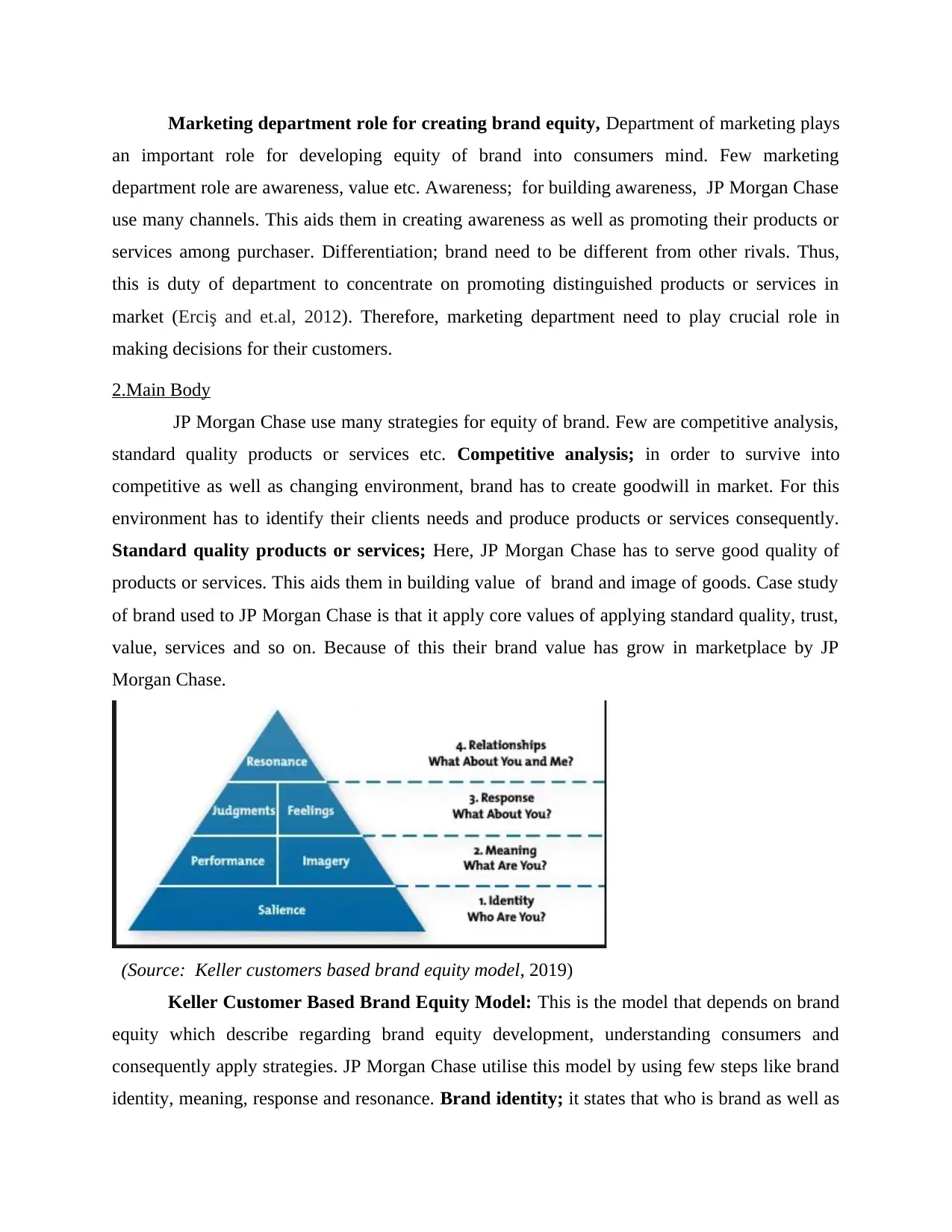
Marketing department role for creating brand equity, Department of marketing plays
an important role for developing equity of brand into consumers mind. Few marketing
department role are awareness, value etc. Awareness; for building awareness, JP Morgan Chase
use many channels. This aids them in creating awareness as well as promoting their products or
services among purchaser. Differentiation; brand need to be different from other rivals. Thus,
this is duty of department to concentrate on promoting distinguished products or services in
market (Erciş and et.al, 2012). Therefore, marketing department need to play crucial role in
making decisions for their customers.
2.Main Body
JP Morgan Chase use many strategies for equity of brand. Few are competitive analysis,
standard quality products or services etc. Competitive analysis; in order to survive into
competitive as well as changing environment, brand has to create goodwill in market. For this
environment has to identify their clients needs and produce products or services consequently.
Standard quality products or services; Here, JP Morgan Chase has to serve good quality of
products or services. This aids them in building value of brand and image of goods. Case study
of brand used to JP Morgan Chase is that it apply core values of applying standard quality, trust,
value, services and so on. Because of this their brand value has grow in marketplace by JP
Morgan Chase.
(Source: Keller customers based brand equity model, 2019)
Keller Customer Based Brand Equity Model: This is the model that depends on brand
equity which describe regarding brand equity development, understanding consumers and
consequently apply strategies. JP Morgan Chase utilise this model by using few steps like brand
identity, meaning, response and resonance. Brand identity; it states that who is brand as well as
an important role for developing equity of brand into consumers mind. Few marketing
department role are awareness, value etc. Awareness; for building awareness, JP Morgan Chase
use many channels. This aids them in creating awareness as well as promoting their products or
services among purchaser. Differentiation; brand need to be different from other rivals. Thus,
this is duty of department to concentrate on promoting distinguished products or services in
market (Erciş and et.al, 2012). Therefore, marketing department need to play crucial role in
making decisions for their customers.
2.Main Body
JP Morgan Chase use many strategies for equity of brand. Few are competitive analysis,
standard quality products or services etc. Competitive analysis; in order to survive into
competitive as well as changing environment, brand has to create goodwill in market. For this
environment has to identify their clients needs and produce products or services consequently.
Standard quality products or services; Here, JP Morgan Chase has to serve good quality of
products or services. This aids them in building value of brand and image of goods. Case study
of brand used to JP Morgan Chase is that it apply core values of applying standard quality, trust,
value, services and so on. Because of this their brand value has grow in marketplace by JP
Morgan Chase.
(Source: Keller customers based brand equity model, 2019)
Keller Customer Based Brand Equity Model: This is the model that depends on brand
equity which describe regarding brand equity development, understanding consumers and
consequently apply strategies. JP Morgan Chase utilise this model by using few steps like brand
identity, meaning, response and resonance. Brand identity; it states that who is brand as well as
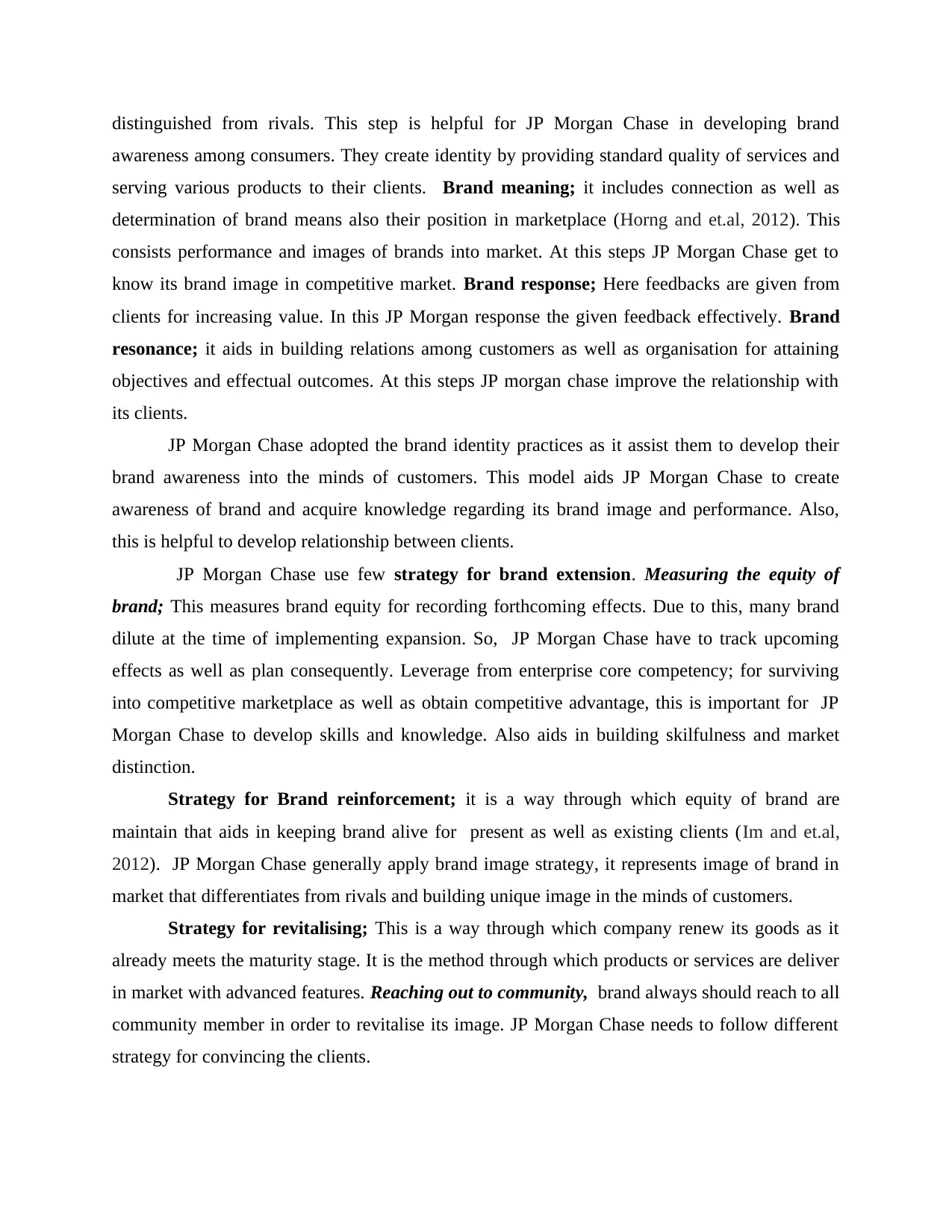
distinguished from rivals. This step is helpful for JP Morgan Chase in developing brand
awareness among consumers. They create identity by providing standard quality of services and
serving various products to their clients. Brand meaning; it includes connection as well as
determination of brand means also their position in marketplace (Horng and et.al, 2012). This
consists performance and images of brands into market. At this steps JP Morgan Chase get to
know its brand image in competitive market. Brand response; Here feedbacks are given from
clients for increasing value. In this JP Morgan response the given feedback effectively. Brand
resonance; it aids in building relations among customers as well as organisation for attaining
objectives and effectual outcomes. At this steps JP morgan chase improve the relationship with
its clients.
JP Morgan Chase adopted the brand identity practices as it assist them to develop their
brand awareness into the minds of customers. This model aids JP Morgan Chase to create
awareness of brand and acquire knowledge regarding its brand image and performance. Also,
this is helpful to develop relationship between clients.
JP Morgan Chase use few strategy for brand extension. Measuring the equity of
brand; This measures brand equity for recording forthcoming effects. Due to this, many brand
dilute at the time of implementing expansion. So, JP Morgan Chase have to track upcoming
effects as well as plan consequently. Leverage from enterprise core competency; for surviving
into competitive marketplace as well as obtain competitive advantage, this is important for JP
Morgan Chase to develop skills and knowledge. Also aids in building skilfulness and market
distinction.
Strategy for Brand reinforcement; it is a way through which equity of brand are
maintain that aids in keeping brand alive for present as well as existing clients (Im and et.al,
2012). JP Morgan Chase generally apply brand image strategy, it represents image of brand in
market that differentiates from rivals and building unique image in the minds of customers.
Strategy for revitalising; This is a way through which company renew its goods as it
already meets the maturity stage. It is the method through which products or services are deliver
in market with advanced features. Reaching out to community, brand always should reach to all
community member in order to revitalise its image. JP Morgan Chase needs to follow different
strategy for convincing the clients.
awareness among consumers. They create identity by providing standard quality of services and
serving various products to their clients. Brand meaning; it includes connection as well as
determination of brand means also their position in marketplace (Horng and et.al, 2012). This
consists performance and images of brands into market. At this steps JP Morgan Chase get to
know its brand image in competitive market. Brand response; Here feedbacks are given from
clients for increasing value. In this JP Morgan response the given feedback effectively. Brand
resonance; it aids in building relations among customers as well as organisation for attaining
objectives and effectual outcomes. At this steps JP morgan chase improve the relationship with
its clients.
JP Morgan Chase adopted the brand identity practices as it assist them to develop their
brand awareness into the minds of customers. This model aids JP Morgan Chase to create
awareness of brand and acquire knowledge regarding its brand image and performance. Also,
this is helpful to develop relationship between clients.
JP Morgan Chase use few strategy for brand extension. Measuring the equity of
brand; This measures brand equity for recording forthcoming effects. Due to this, many brand
dilute at the time of implementing expansion. So, JP Morgan Chase have to track upcoming
effects as well as plan consequently. Leverage from enterprise core competency; for surviving
into competitive marketplace as well as obtain competitive advantage, this is important for JP
Morgan Chase to develop skills and knowledge. Also aids in building skilfulness and market
distinction.
Strategy for Brand reinforcement; it is a way through which equity of brand are
maintain that aids in keeping brand alive for present as well as existing clients (Im and et.al,
2012). JP Morgan Chase generally apply brand image strategy, it represents image of brand in
market that differentiates from rivals and building unique image in the minds of customers.
Strategy for revitalising; This is a way through which company renew its goods as it
already meets the maturity stage. It is the method through which products or services are deliver
in market with advanced features. Reaching out to community, brand always should reach to all
community member in order to revitalise its image. JP Morgan Chase needs to follow different
strategy for convincing the clients.
⊘ This is a preview!⊘
Do you want full access?
Subscribe today to unlock all pages.

Trusted by 1+ million students worldwide
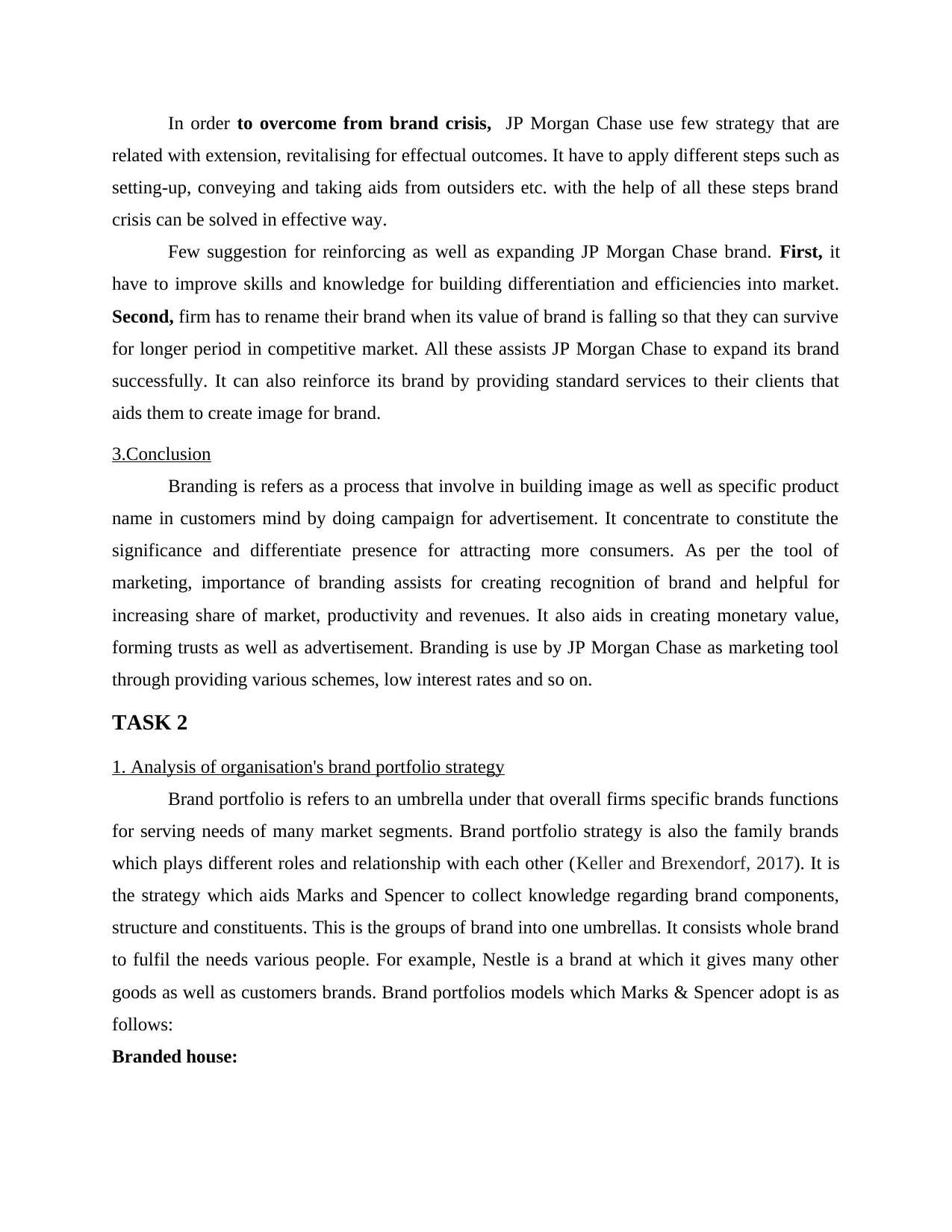
In order to overcome from brand crisis, JP Morgan Chase use few strategy that are
related with extension, revitalising for effectual outcomes. It have to apply different steps such as
setting-up, conveying and taking aids from outsiders etc. with the help of all these steps brand
crisis can be solved in effective way.
Few suggestion for reinforcing as well as expanding JP Morgan Chase brand. First, it
have to improve skills and knowledge for building differentiation and efficiencies into market.
Second, firm has to rename their brand when its value of brand is falling so that they can survive
for longer period in competitive market. All these assists JP Morgan Chase to expand its brand
successfully. It can also reinforce its brand by providing standard services to their clients that
aids them to create image for brand.
3.Conclusion
Branding is refers as a process that involve in building image as well as specific product
name in customers mind by doing campaign for advertisement. It concentrate to constitute the
significance and differentiate presence for attracting more consumers. As per the tool of
marketing, importance of branding assists for creating recognition of brand and helpful for
increasing share of market, productivity and revenues. It also aids in creating monetary value,
forming trusts as well as advertisement. Branding is use by JP Morgan Chase as marketing tool
through providing various schemes, low interest rates and so on.
TASK 2
1. Analysis of organisation's brand portfolio strategy
Brand portfolio is refers to an umbrella under that overall firms specific brands functions
for serving needs of many market segments. Brand portfolio strategy is also the family brands
which plays different roles and relationship with each other (Keller and Brexendorf, 2017). It is
the strategy which aids Marks and Spencer to collect knowledge regarding brand components,
structure and constituents. This is the groups of brand into one umbrellas. It consists whole brand
to fulfil the needs various people. For example, Nestle is a brand at which it gives many other
goods as well as customers brands. Brand portfolios models which Marks & Spencer adopt is as
follows:
Branded house:
related with extension, revitalising for effectual outcomes. It have to apply different steps such as
setting-up, conveying and taking aids from outsiders etc. with the help of all these steps brand
crisis can be solved in effective way.
Few suggestion for reinforcing as well as expanding JP Morgan Chase brand. First, it
have to improve skills and knowledge for building differentiation and efficiencies into market.
Second, firm has to rename their brand when its value of brand is falling so that they can survive
for longer period in competitive market. All these assists JP Morgan Chase to expand its brand
successfully. It can also reinforce its brand by providing standard services to their clients that
aids them to create image for brand.
3.Conclusion
Branding is refers as a process that involve in building image as well as specific product
name in customers mind by doing campaign for advertisement. It concentrate to constitute the
significance and differentiate presence for attracting more consumers. As per the tool of
marketing, importance of branding assists for creating recognition of brand and helpful for
increasing share of market, productivity and revenues. It also aids in creating monetary value,
forming trusts as well as advertisement. Branding is use by JP Morgan Chase as marketing tool
through providing various schemes, low interest rates and so on.
TASK 2
1. Analysis of organisation's brand portfolio strategy
Brand portfolio is refers to an umbrella under that overall firms specific brands functions
for serving needs of many market segments. Brand portfolio strategy is also the family brands
which plays different roles and relationship with each other (Keller and Brexendorf, 2017). It is
the strategy which aids Marks and Spencer to collect knowledge regarding brand components,
structure and constituents. This is the groups of brand into one umbrellas. It consists whole brand
to fulfil the needs various people. For example, Nestle is a brand at which it gives many other
goods as well as customers brands. Brand portfolios models which Marks & Spencer adopt is as
follows:
Branded house:
Paraphrase This Document
Need a fresh take? Get an instant paraphrase of this document with our AI Paraphraser
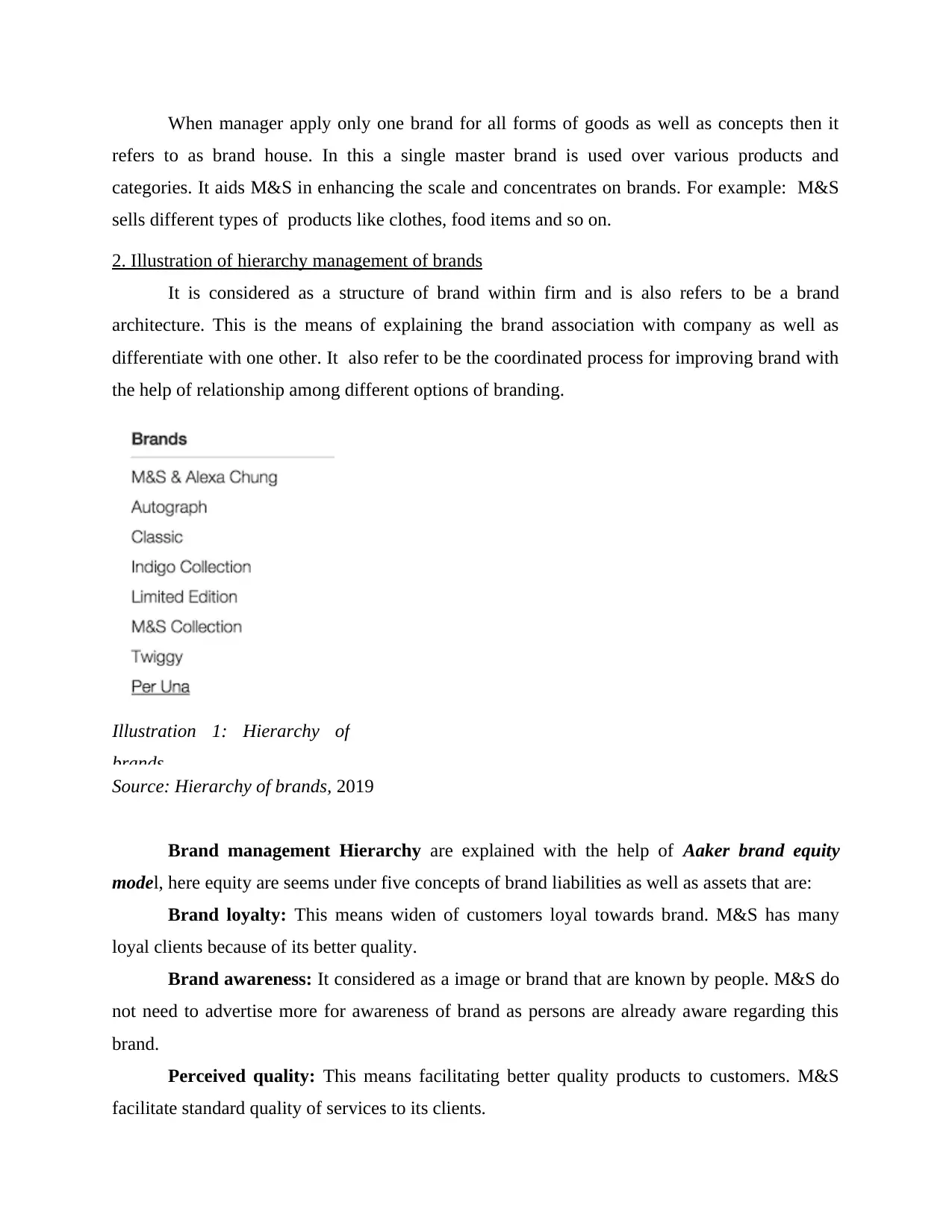
When manager apply only one brand for all forms of goods as well as concepts then it
refers to as brand house. In this a single master brand is used over various products and
categories. It aids M&S in enhancing the scale and concentrates on brands. For example: M&S
sells different types of products like clothes, food items and so on.
2. Illustration of hierarchy management of brands
It is considered as a structure of brand within firm and is also refers to be a brand
architecture. This is the means of explaining the brand association with company as well as
differentiate with one other. It also refer to be the coordinated process for improving brand with
the help of relationship among different options of branding.
Illustration 1: Hierarchy of
brands
Source: Hierarchy of brands, 2019
Brand management Hierarchy are explained with the help of Aaker brand equity
model, here equity are seems under five concepts of brand liabilities as well as assets that are:
Brand loyalty: This means widen of customers loyal towards brand. M&S has many
loyal clients because of its better quality.
Brand awareness: It considered as a image or brand that are known by people. M&S do
not need to advertise more for awareness of brand as persons are already aware regarding this
brand.
Perceived quality: This means facilitating better quality products to customers. M&S
facilitate standard quality of services to its clients.
refers to as brand house. In this a single master brand is used over various products and
categories. It aids M&S in enhancing the scale and concentrates on brands. For example: M&S
sells different types of products like clothes, food items and so on.
2. Illustration of hierarchy management of brands
It is considered as a structure of brand within firm and is also refers to be a brand
architecture. This is the means of explaining the brand association with company as well as
differentiate with one other. It also refer to be the coordinated process for improving brand with
the help of relationship among different options of branding.
Illustration 1: Hierarchy of
brands
Source: Hierarchy of brands, 2019
Brand management Hierarchy are explained with the help of Aaker brand equity
model, here equity are seems under five concepts of brand liabilities as well as assets that are:
Brand loyalty: This means widen of customers loyal towards brand. M&S has many
loyal clients because of its better quality.
Brand awareness: It considered as a image or brand that are known by people. M&S do
not need to advertise more for awareness of brand as persons are already aware regarding this
brand.
Perceived quality: This means facilitating better quality products to customers. M&S
facilitate standard quality of services to its clients.
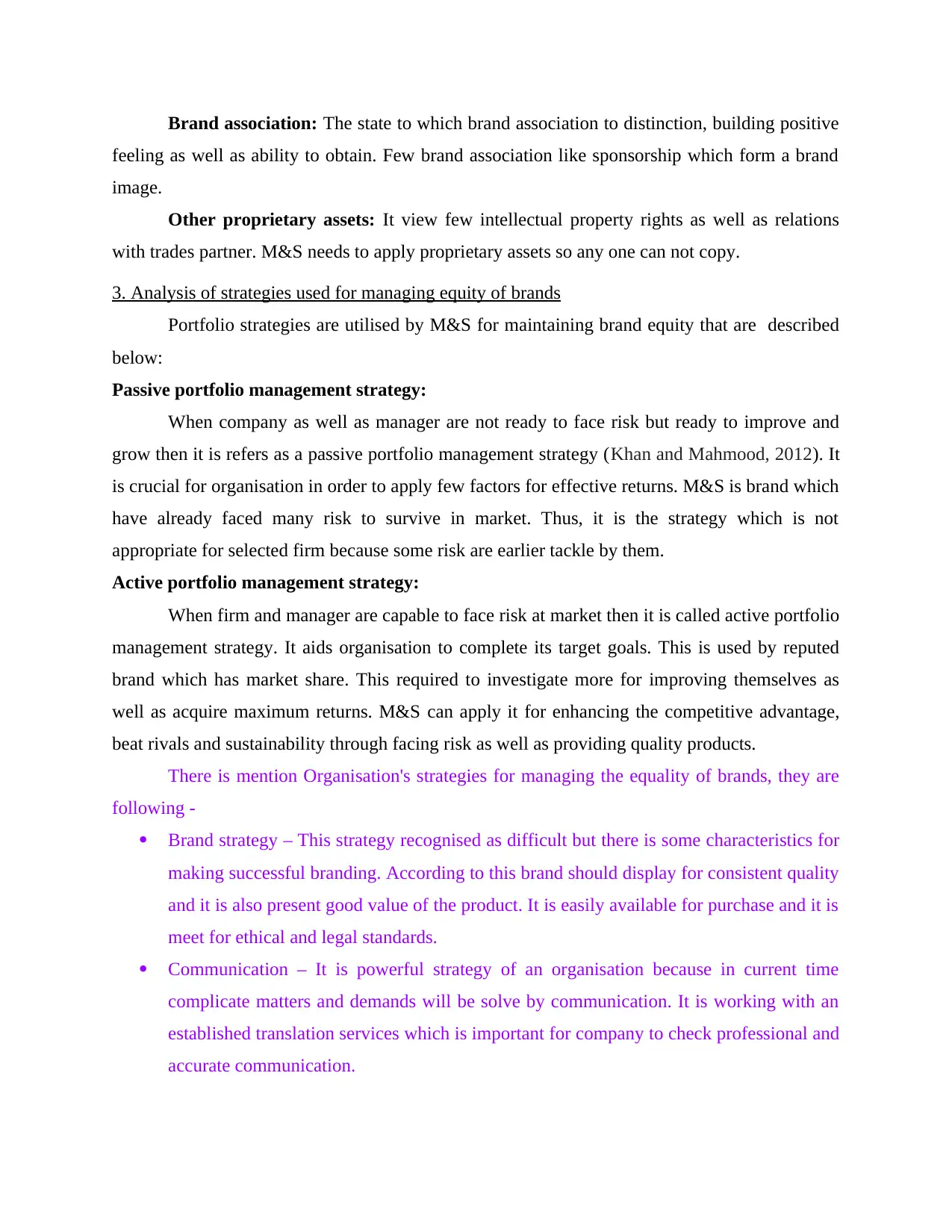
Brand association: The state to which brand association to distinction, building positive
feeling as well as ability to obtain. Few brand association like sponsorship which form a brand
image.
Other proprietary assets: It view few intellectual property rights as well as relations
with trades partner. M&S needs to apply proprietary assets so any one can not copy.
3. Analysis of strategies used for managing equity of brands
Portfolio strategies are utilised by M&S for maintaining brand equity that are described
below:
Passive portfolio management strategy:
When company as well as manager are not ready to face risk but ready to improve and
grow then it is refers as a passive portfolio management strategy (Khan and Mahmood, 2012). It
is crucial for organisation in order to apply few factors for effective returns. M&S is brand which
have already faced many risk to survive in market. Thus, it is the strategy which is not
appropriate for selected firm because some risk are earlier tackle by them.
Active portfolio management strategy:
When firm and manager are capable to face risk at market then it is called active portfolio
management strategy. It aids organisation to complete its target goals. This is used by reputed
brand which has market share. This required to investigate more for improving themselves as
well as acquire maximum returns. M&S can apply it for enhancing the competitive advantage,
beat rivals and sustainability through facing risk as well as providing quality products.
There is mention Organisation's strategies for managing the equality of brands, they are
following -
Brand strategy – This strategy recognised as difficult but there is some characteristics for
making successful branding. According to this brand should display for consistent quality
and it is also present good value of the product. It is easily available for purchase and it is
meet for ethical and legal standards.
Communication – It is powerful strategy of an organisation because in current time
complicate matters and demands will be solve by communication. It is working with an
established translation services which is important for company to check professional and
accurate communication.
feeling as well as ability to obtain. Few brand association like sponsorship which form a brand
image.
Other proprietary assets: It view few intellectual property rights as well as relations
with trades partner. M&S needs to apply proprietary assets so any one can not copy.
3. Analysis of strategies used for managing equity of brands
Portfolio strategies are utilised by M&S for maintaining brand equity that are described
below:
Passive portfolio management strategy:
When company as well as manager are not ready to face risk but ready to improve and
grow then it is refers as a passive portfolio management strategy (Khan and Mahmood, 2012). It
is crucial for organisation in order to apply few factors for effective returns. M&S is brand which
have already faced many risk to survive in market. Thus, it is the strategy which is not
appropriate for selected firm because some risk are earlier tackle by them.
Active portfolio management strategy:
When firm and manager are capable to face risk at market then it is called active portfolio
management strategy. It aids organisation to complete its target goals. This is used by reputed
brand which has market share. This required to investigate more for improving themselves as
well as acquire maximum returns. M&S can apply it for enhancing the competitive advantage,
beat rivals and sustainability through facing risk as well as providing quality products.
There is mention Organisation's strategies for managing the equality of brands, they are
following -
Brand strategy – This strategy recognised as difficult but there is some characteristics for
making successful branding. According to this brand should display for consistent quality
and it is also present good value of the product. It is easily available for purchase and it is
meet for ethical and legal standards.
Communication – It is powerful strategy of an organisation because in current time
complicate matters and demands will be solve by communication. It is working with an
established translation services which is important for company to check professional and
accurate communication.
⊘ This is a preview!⊘
Do you want full access?
Subscribe today to unlock all pages.

Trusted by 1+ million students worldwide
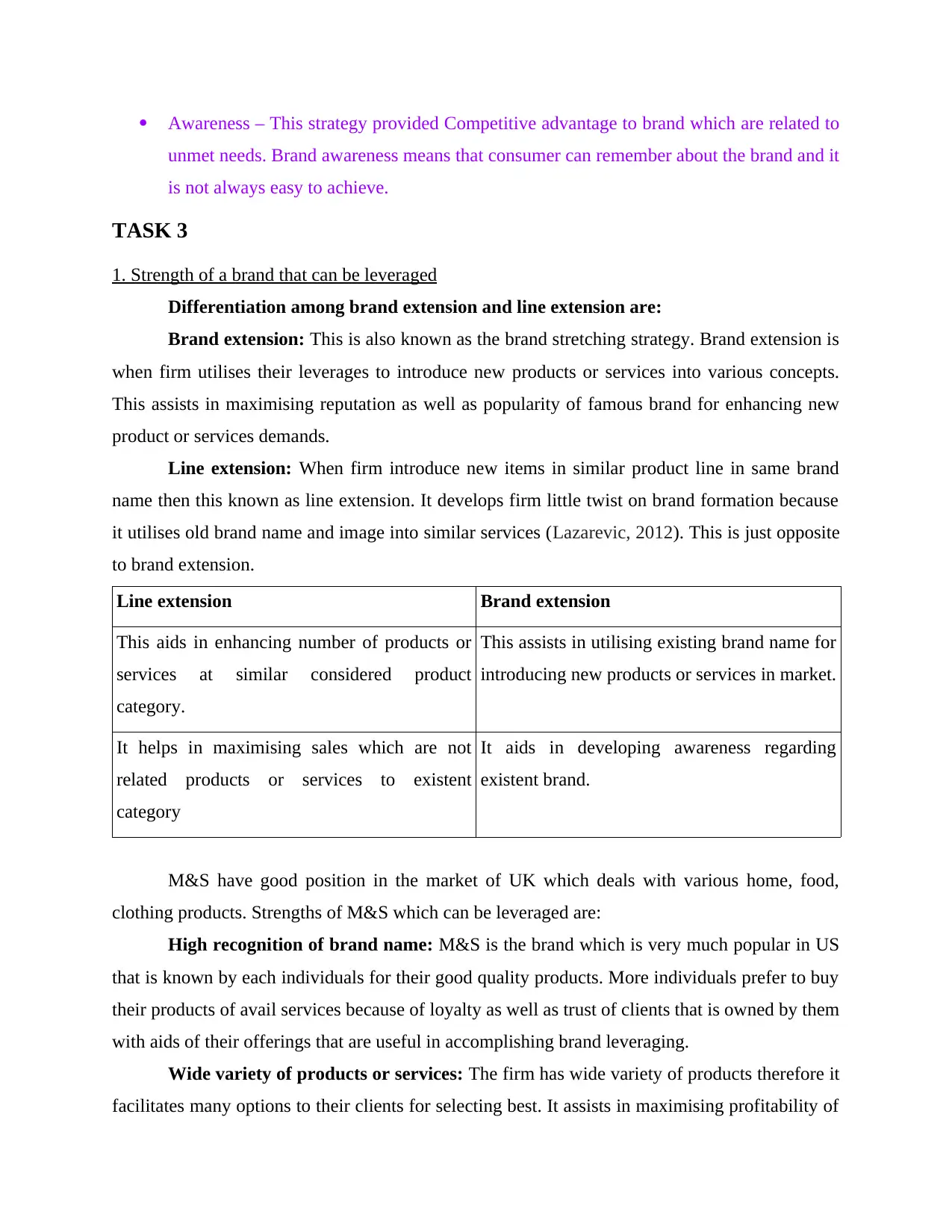
Awareness – This strategy provided Competitive advantage to brand which are related to
unmet needs. Brand awareness means that consumer can remember about the brand and it
is not always easy to achieve.
TASK 3
1. Strength of a brand that can be leveraged
Differentiation among brand extension and line extension are:
Brand extension: This is also known as the brand stretching strategy. Brand extension is
when firm utilises their leverages to introduce new products or services into various concepts.
This assists in maximising reputation as well as popularity of famous brand for enhancing new
product or services demands.
Line extension: When firm introduce new items in similar product line in same brand
name then this known as line extension. It develops firm little twist on brand formation because
it utilises old brand name and image into similar services (Lazarevic, 2012). This is just opposite
to brand extension.
Line extension Brand extension
This aids in enhancing number of products or
services at similar considered product
category.
This assists in utilising existing brand name for
introducing new products or services in market.
It helps in maximising sales which are not
related products or services to existent
category
It aids in developing awareness regarding
existent brand.
M&S have good position in the market of UK which deals with various home, food,
clothing products. Strengths of M&S which can be leveraged are:
High recognition of brand name: M&S is the brand which is very much popular in US
that is known by each individuals for their good quality products. More individuals prefer to buy
their products of avail services because of loyalty as well as trust of clients that is owned by them
with aids of their offerings that are useful in accomplishing brand leveraging.
Wide variety of products or services: The firm has wide variety of products therefore it
facilitates many options to their clients for selecting best. It assists in maximising profitability of
unmet needs. Brand awareness means that consumer can remember about the brand and it
is not always easy to achieve.
TASK 3
1. Strength of a brand that can be leveraged
Differentiation among brand extension and line extension are:
Brand extension: This is also known as the brand stretching strategy. Brand extension is
when firm utilises their leverages to introduce new products or services into various concepts.
This assists in maximising reputation as well as popularity of famous brand for enhancing new
product or services demands.
Line extension: When firm introduce new items in similar product line in same brand
name then this known as line extension. It develops firm little twist on brand formation because
it utilises old brand name and image into similar services (Lazarevic, 2012). This is just opposite
to brand extension.
Line extension Brand extension
This aids in enhancing number of products or
services at similar considered product
category.
This assists in utilising existing brand name for
introducing new products or services in market.
It helps in maximising sales which are not
related products or services to existent
category
It aids in developing awareness regarding
existent brand.
M&S have good position in the market of UK which deals with various home, food,
clothing products. Strengths of M&S which can be leveraged are:
High recognition of brand name: M&S is the brand which is very much popular in US
that is known by each individuals for their good quality products. More individuals prefer to buy
their products of avail services because of loyalty as well as trust of clients that is owned by them
with aids of their offerings that are useful in accomplishing brand leveraging.
Wide variety of products or services: The firm has wide variety of products therefore it
facilitates many options to their clients for selecting best. It assists in maximising profitability of
Paraphrase This Document
Need a fresh take? Get an instant paraphrase of this document with our AI Paraphraser
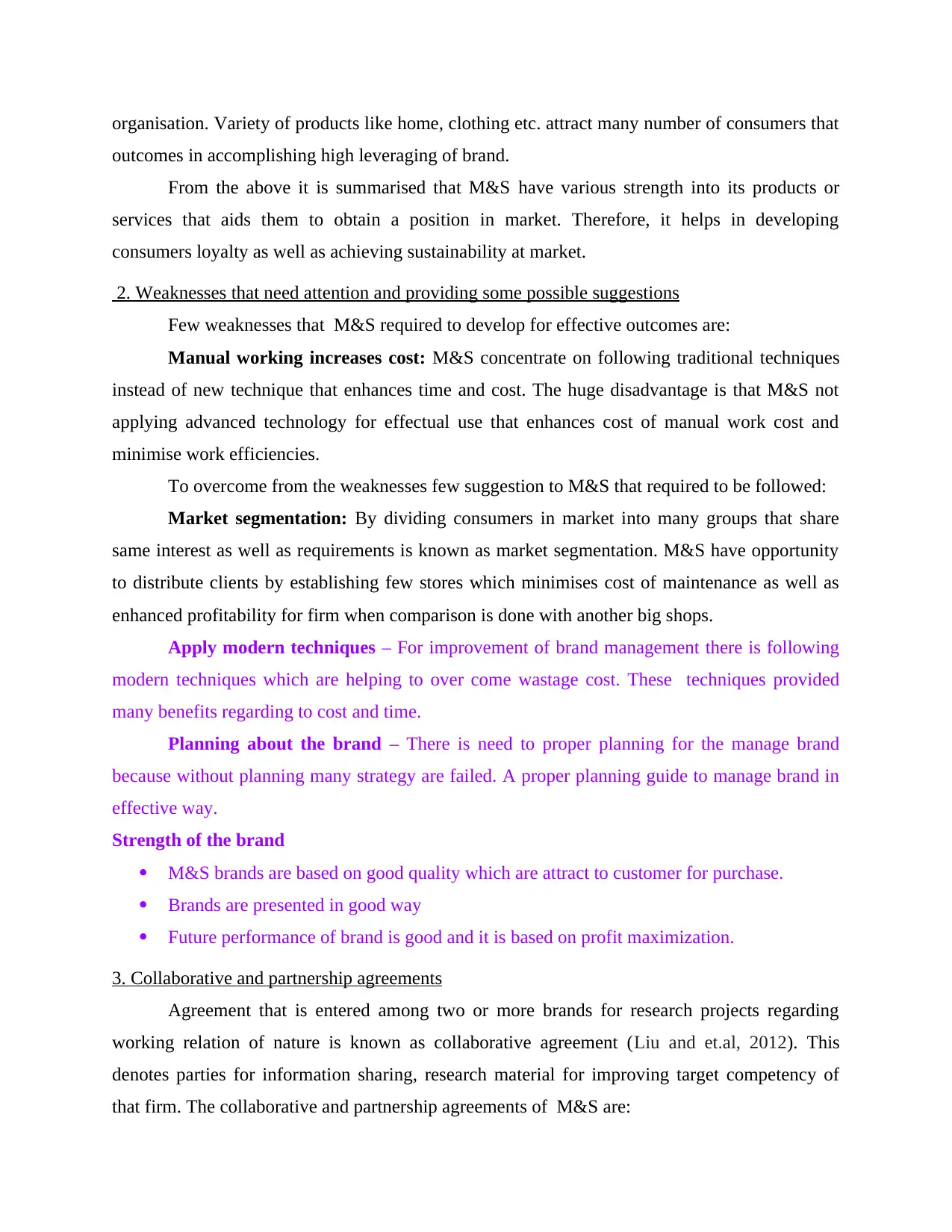
organisation. Variety of products like home, clothing etc. attract many number of consumers that
outcomes in accomplishing high leveraging of brand.
From the above it is summarised that M&S have various strength into its products or
services that aids them to obtain a position in market. Therefore, it helps in developing
consumers loyalty as well as achieving sustainability at market.
2. Weaknesses that need attention and providing some possible suggestions
Few weaknesses that M&S required to develop for effective outcomes are:
Manual working increases cost: M&S concentrate on following traditional techniques
instead of new technique that enhances time and cost. The huge disadvantage is that M&S not
applying advanced technology for effectual use that enhances cost of manual work cost and
minimise work efficiencies.
To overcome from the weaknesses few suggestion to M&S that required to be followed:
Market segmentation: By dividing consumers in market into many groups that share
same interest as well as requirements is known as market segmentation. M&S have opportunity
to distribute clients by establishing few stores which minimises cost of maintenance as well as
enhanced profitability for firm when comparison is done with another big shops.
Apply modern techniques – For improvement of brand management there is following
modern techniques which are helping to over come wastage cost. These techniques provided
many benefits regarding to cost and time.
Planning about the brand – There is need to proper planning for the manage brand
because without planning many strategy are failed. A proper planning guide to manage brand in
effective way.
Strength of the brand
M&S brands are based on good quality which are attract to customer for purchase.
Brands are presented in good way
Future performance of brand is good and it is based on profit maximization.
3. Collaborative and partnership agreements
Agreement that is entered among two or more brands for research projects regarding
working relation of nature is known as collaborative agreement (Liu and et.al, 2012). This
denotes parties for information sharing, research material for improving target competency of
that firm. The collaborative and partnership agreements of M&S are:
outcomes in accomplishing high leveraging of brand.
From the above it is summarised that M&S have various strength into its products or
services that aids them to obtain a position in market. Therefore, it helps in developing
consumers loyalty as well as achieving sustainability at market.
2. Weaknesses that need attention and providing some possible suggestions
Few weaknesses that M&S required to develop for effective outcomes are:
Manual working increases cost: M&S concentrate on following traditional techniques
instead of new technique that enhances time and cost. The huge disadvantage is that M&S not
applying advanced technology for effectual use that enhances cost of manual work cost and
minimise work efficiencies.
To overcome from the weaknesses few suggestion to M&S that required to be followed:
Market segmentation: By dividing consumers in market into many groups that share
same interest as well as requirements is known as market segmentation. M&S have opportunity
to distribute clients by establishing few stores which minimises cost of maintenance as well as
enhanced profitability for firm when comparison is done with another big shops.
Apply modern techniques – For improvement of brand management there is following
modern techniques which are helping to over come wastage cost. These techniques provided
many benefits regarding to cost and time.
Planning about the brand – There is need to proper planning for the manage brand
because without planning many strategy are failed. A proper planning guide to manage brand in
effective way.
Strength of the brand
M&S brands are based on good quality which are attract to customer for purchase.
Brands are presented in good way
Future performance of brand is good and it is based on profit maximization.
3. Collaborative and partnership agreements
Agreement that is entered among two or more brands for research projects regarding
working relation of nature is known as collaborative agreement (Liu and et.al, 2012). This
denotes parties for information sharing, research material for improving target competency of
that firm. The collaborative and partnership agreements of M&S are:
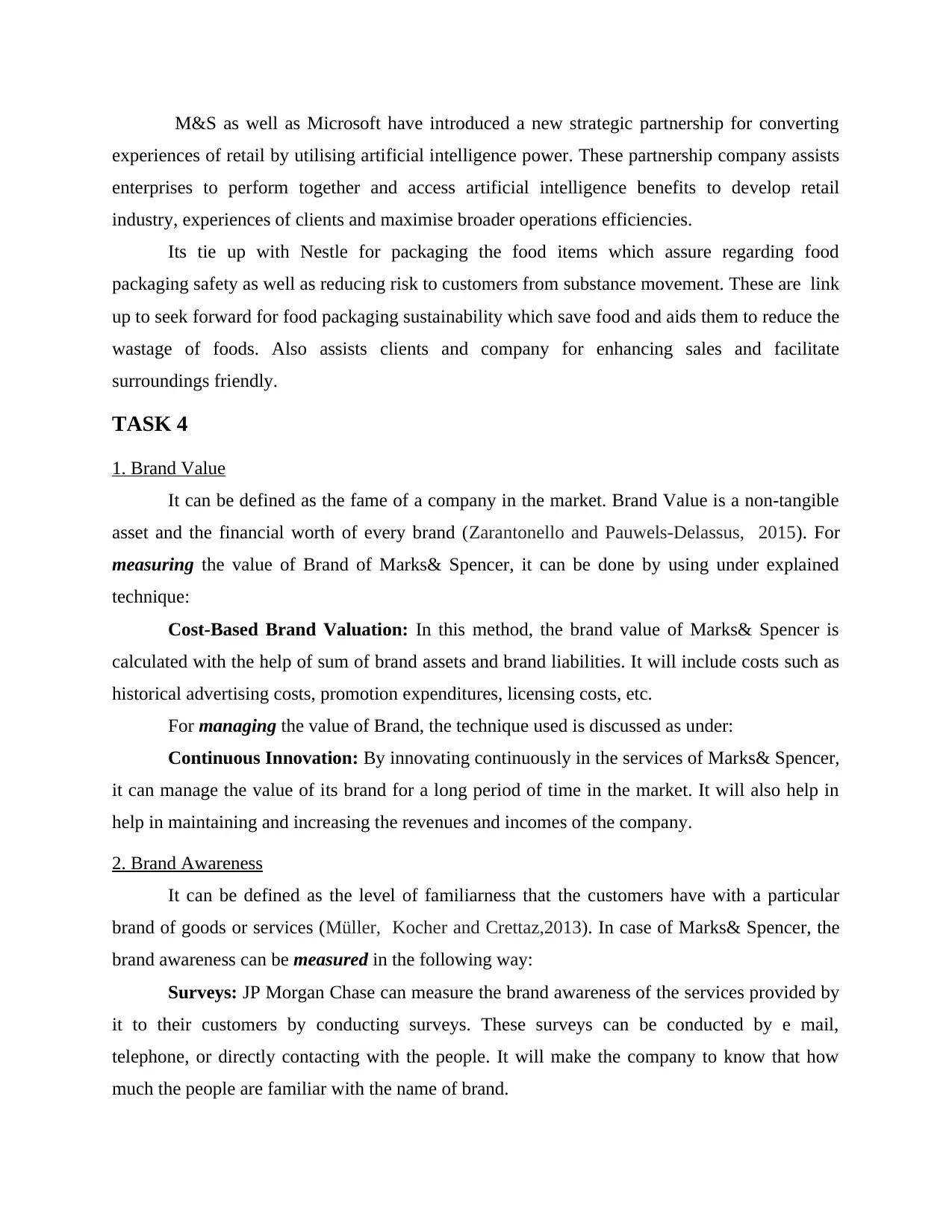
M&S as well as Microsoft have introduced a new strategic partnership for converting
experiences of retail by utilising artificial intelligence power. These partnership company assists
enterprises to perform together and access artificial intelligence benefits to develop retail
industry, experiences of clients and maximise broader operations efficiencies.
Its tie up with Nestle for packaging the food items which assure regarding food
packaging safety as well as reducing risk to customers from substance movement. These are link
up to seek forward for food packaging sustainability which save food and aids them to reduce the
wastage of foods. Also assists clients and company for enhancing sales and facilitate
surroundings friendly.
TASK 4
1. Brand Value
It can be defined as the fame of a company in the market. Brand Value is a non-tangible
asset and the financial worth of every brand (Zarantonello and Pauwels-Delassus, 2015). For
measuring the value of Brand of Marks& Spencer, it can be done by using under explained
technique:
Cost-Based Brand Valuation: In this method, the brand value of Marks& Spencer is
calculated with the help of sum of brand assets and brand liabilities. It will include costs such as
historical advertising costs, promotion expenditures, licensing costs, etc.
For managing the value of Brand, the technique used is discussed as under:
Continuous Innovation: By innovating continuously in the services of Marks& Spencer,
it can manage the value of its brand for a long period of time in the market. It will also help in
help in maintaining and increasing the revenues and incomes of the company.
2. Brand Awareness
It can be defined as the level of familiarness that the customers have with a particular
brand of goods or services (Müller, Kocher and Crettaz,2013). In case of Marks& Spencer, the
brand awareness can be measured in the following way:
Surveys: JP Morgan Chase can measure the brand awareness of the services provided by
it to their customers by conducting surveys. These surveys can be conducted by e mail,
telephone, or directly contacting with the people. It will make the company to know that how
much the people are familiar with the name of brand.
experiences of retail by utilising artificial intelligence power. These partnership company assists
enterprises to perform together and access artificial intelligence benefits to develop retail
industry, experiences of clients and maximise broader operations efficiencies.
Its tie up with Nestle for packaging the food items which assure regarding food
packaging safety as well as reducing risk to customers from substance movement. These are link
up to seek forward for food packaging sustainability which save food and aids them to reduce the
wastage of foods. Also assists clients and company for enhancing sales and facilitate
surroundings friendly.
TASK 4
1. Brand Value
It can be defined as the fame of a company in the market. Brand Value is a non-tangible
asset and the financial worth of every brand (Zarantonello and Pauwels-Delassus, 2015). For
measuring the value of Brand of Marks& Spencer, it can be done by using under explained
technique:
Cost-Based Brand Valuation: In this method, the brand value of Marks& Spencer is
calculated with the help of sum of brand assets and brand liabilities. It will include costs such as
historical advertising costs, promotion expenditures, licensing costs, etc.
For managing the value of Brand, the technique used is discussed as under:
Continuous Innovation: By innovating continuously in the services of Marks& Spencer,
it can manage the value of its brand for a long period of time in the market. It will also help in
help in maintaining and increasing the revenues and incomes of the company.
2. Brand Awareness
It can be defined as the level of familiarness that the customers have with a particular
brand of goods or services (Müller, Kocher and Crettaz,2013). In case of Marks& Spencer, the
brand awareness can be measured in the following way:
Surveys: JP Morgan Chase can measure the brand awareness of the services provided by
it to their customers by conducting surveys. These surveys can be conducted by e mail,
telephone, or directly contacting with the people. It will make the company to know that how
much the people are familiar with the name of brand.
⊘ This is a preview!⊘
Do you want full access?
Subscribe today to unlock all pages.

Trusted by 1+ million students worldwide
1 out of 15
Related Documents
Your All-in-One AI-Powered Toolkit for Academic Success.
+13062052269
info@desklib.com
Available 24*7 on WhatsApp / Email
![[object Object]](/_next/static/media/star-bottom.7253800d.svg)
Unlock your academic potential
Copyright © 2020–2025 A2Z Services. All Rights Reserved. Developed and managed by ZUCOL.



